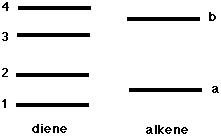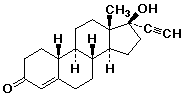Chem 336 - Spring 1999 - Organic Chemistry III
Portland State University - Dr. Carl C. Wamser
ConcepTests - The Questions
Listed below are the ConcepTests used in class, in the order they appeared. New questions and references to other related questions will be added as they become available. Boldface indicates the correct answer.
These ConcepTests cover Chapters 20-28 in the Brown & Foote text.
ConcepTests for Chapters 1-9 are with the Chem 334 web pages.
ConcepTests for Chapters 10-19 are with the Chem 335 web pages.
Chapter 20 - Aromatic Substitution Reactions
98. Which of the compounds below would be expected to react the most rapidly with a typical electrophile like Br2 ? D
99. Electrophilic aromatic substitution amounts to replacement
of E+ for H+ on an aromatic ring.
 D = heavy hydrogen (deuterium)
D = heavy hydrogen (deuterium)
If a benzene ring included both H and D, the reaction (compared to normal benzene) would be expected to be:
A faster, replacing D more than H
B faster, replacing H more than D
C slower, replacing H more than D
D same rate, replacing H and D equally
100. Predict the characteristics of -NH3+ as a substituent.
A activating, o/p directing
B activating, m-directing
C deactivating, o/p directing
D deactivating, m-directing
101. Predict the characteristics of -CN as a substituent.
A activating, o/p directing
B activating, m-directing
C deactivating, o/p directing
D deactivating, m-directing
102. Predict the characteristics of -OCH2CH3 as a substituent.
A activating, o/p directing
B activating, m-directing
C deactivating, o/p directing
D deactivating, m-directing
103. To prepare m-chloronitrobenzene from benzene, one should
A first nitrate, then chlorinate
B first chlorinate, then nitrate
104. The preferred position for nitration of 4-hydroxybenzoic acid is
A 1
B 2
C 3
D 4
105. How many different isomers are there for trichlorobenzene?
A 2
B 3
C 4
D 5
106. How many different isomers are there for bromochlorophenol?
A 4
B 6
C 8
D 10
107. Challenge problem:
An old method for determining whether a disubstituted benzene was ortho, meta, or para was to perform a nitration and count the number of different mononitration products that could be isolated.
a) Apply this to the three dichlorobenzenes and indicate how the method could distinguish them.
b) Does the method work with bromochlorobenzene?
c) Does the method work with chloronitrobenzene?
d) This method does involve an assumption about nitration reactions and substituent effects. What is it?
108. The major product from the Friedel-Crafts reaction of 1-bromobutane with AlBr3 and benzene is likely to be
A bromobenzene
B butylbenzene
C sec-butylbenzene
D tert-butylbenzene
109. Which of the following will react most rapidly in a nucleophilic substitution reaction?
A

Chapter 21 - Amines
110. A mixture of (a) triethylamine, (b) benzoic acid, and
(c) butylbenzene is dissolved in diethyl ether.
The ether solution is shaken with aqueous HCl, then separated,
and the aqueous solution is saved in flask 1.
The ether solution is next shaken with aqueous NaOH, then separated,
and that aqueous solution is saved in flask 2. The ether solution
is saved in flask 3.
The original three compounds are now located in flasks 1, 2, and
3. Who's where?
A 1 (a) , 2 (b) , 3 (c)
B 1 (a) , 2 (c) , 3 (b)
C 1 (b) , 2 (a) , 3 (c)
D 1 (b) , 2 (c) , 3 (a)
111. In order to maximize the yield of butyl amine, the reaction of bromobutane with ammonia should be carried out
A with excess bromobutane
B with excess ammonia
C by slow addition of ammonia
D at low temperature
112. A reaction sequence that would convert benzene into fluorobenzene would likely involve all of the following EXCEPT
A benzenediazonium ion
B nitrobenzene
C aniline
D phenol
113. Repeated cycles of exhaustive methylation and Hofmann elimination on the amine below will eventually give a product with no nitrogen and the formula
A C7H10
B C7H12
C C6H10
D C4H8
Chapter 22 - Conjugated Dienes
114. Consider the radical cation that would result from removal of one electron from 1,3-butadiene. All of the following are reasonable resonance forms EXCEPT B

115. The pi MOs of a typical diene and an alkene are shown below. The Diels-Alder reaction works best with electron-deficient alkenes because this improves the bonding interaction between MOs

A 1 and a
B 2 and a
C 3 and a
D 2 and b
116. In some cases, a Diels-Alder reaction occurs when the diene is electron-deficient and the alkene is electron-rich, in which case the bonding interaction is improved between MOs
A 2 and a
B 3 and a
C 2 and b
D 3 and b
Chapter 23 - Polymers
117. When a condensation polymerization is half complete, the average degree of polymerization is about
A 1
B 2
C 4
D a high number
118. When a chain polymerization is half complete, the average degree of polymerization is about
A 1
B 2
C 4
D a high number
119. Biological polymers, such as proteins, are made by a process that resembles
A chain polymerization
B condensation polymerization
C both
D neither
Chapter 24 - Carbohydrates
120. Pure alpha-D-glucopyranose has [a] = +112° . Pure beta-D-glucopyranose has [a] = +19° . After mutarotation equilibrium, [a] =
A some negative value
B between 0° and +19°
C the average of +19° and +112°
D some other value between +19° and +112°
2. Fructose exists to a significant degree as a pyranose structure, in which C-6 and C-2 are joined in a hemiketal linkage.
Identify the 6 carbons of fructose on the chair form shown below.
Carbon 'a' corresponds to fructose carbon number
A 1
B 2
C 5
D 6
Assume the anomeric carbon 'a' has a beta OH group.
What's the other substituent on carbon 'a' ? CH2OH
Is the OH group on carbon 'b' up or down ? axial or
equatorial ?
Is the OH group on carbon 'c' up or down ? axial or equatorial
?
Is the OH group on carbon 'd' up or down ? axial
or equatorial ?
Is the OH group on carbon 'e' up or down ? there is none
Is this the most stable conformation? probably
122. The complete periodate cleavage of glucose would give
A 5 HCOOH + 1 H2CO
B 5 H2CO + 1 HCOOH
C 1 CO2 + 1 H2CO + 4 HCOOH
D 1 CO2 + 1 HCOOH + 4 H2CO
123. Compared to glucose, the complete periodate cleavage of fructose would give
A the same fragments
B 1 CO2 instead of a HCOOH
C 1 extra H2CO instead of a HCOOH
D both B & C
Chapter 25 - Lipids
124. When mevalonic acid is biosynthesized from acetyl-CoA, the methyl groups of acetyl-CoA are most likely found in mevalonic acid as carbons

A 2, 4, 5, 6
B 2, 4, 6
C 2, 5, 6
D 2, 6
125. The unusual alkyne functional group in norethindrone is probably introduced synthetically by

A addition to a ketone
B oxidation of an alkene
C elimination from a dibromide
D epoxide ring opening
Chapter 26 - Metabolism
126. The pKa values for phosphoric acid are about 2, 7, and 12. At pH ~ 7, the average charge on phosphoric acid would be expected to be
A about 0
B between 0 and 1
C about 1
D between 1 and 2
127. The pKa values for phosphoric acid are about 2, 7, and 12. At pH ~ 7, the average charge on a phosphate monoester would be expected to be
A about 0
B between 0 and 1
C about 1
D between 1 and 2
128. The pKa values for phosphoric acid are about 2, 7, and 12. At pH ~ 7, the average charge on a phosphate diester would be expected to be
A about 0
B between 0 and 1
C about 1
D between 1 and 2
129. The pKa values for phosphoric acid are about 2, 7, and 12. At pH ~ 7, the average charge on a phosphate triester would be expected to be
A about 0
B between 0 and 1
C about 1
D between 1 and 2
130. The pKa values for phosphoric acid are about 2, 7, and 12. At pH ~ 7, the average charge on ATP would be expected to be
A about 1
B about 2
C about 3
D over 3
Chapter 27 - Amino Acids & Proteins
131. The expected charge on valine at pH 7 is approximately
A -1
B neutral
C +1
132. The expected charge on valine at pH 1 is
A negative
B neutral
C positive
133. The expected charge on valine at pH 10 is
A negative
B neutral
C positive
134. Given pKa values of about 2.3 and 9.7 for valine, the expected charge on valine at pH 7 is slightly
A negative
B positive
135. Given a side-chain pKa value of about 10, the expected charge on lysine at pH 7 is about
A -1
B 0
C +1
D +2
136. At pH 7, the expected charge on the dipeptide TrpArg is about
A -1
B 0
C +1
D +2
137. The strongest H-bonding would be expected between the side chains of which pair?
A Leu - Lys
B His - Phe
C Glu - Tyr
D Arg - Lys
138. Which amino acid substitution is most likely to cause a significant change in a protein's structure and/or function?
A Val to Leu
B His to Trp
C Arg to Lys
D Glu to Asp
Chapter 28 - Nucleic Acids
139. What is the complementary DNA strand to:
5'-CGTCAGGTT-3'
Written in the standard direction, the first base is
A A
B G
C C
D T
140. Challenge problem:
Nitrite (NO2-) or nitrous acid (HONO) can act as a mutagen, in
that it converts C to U.
a) Show how this reaction might occur.
b) Illustrate two cases where a C to U mutation would NOT affect
protein synthesis.
c) Identify the case where such a mutation could cause the MOST
drastic change.